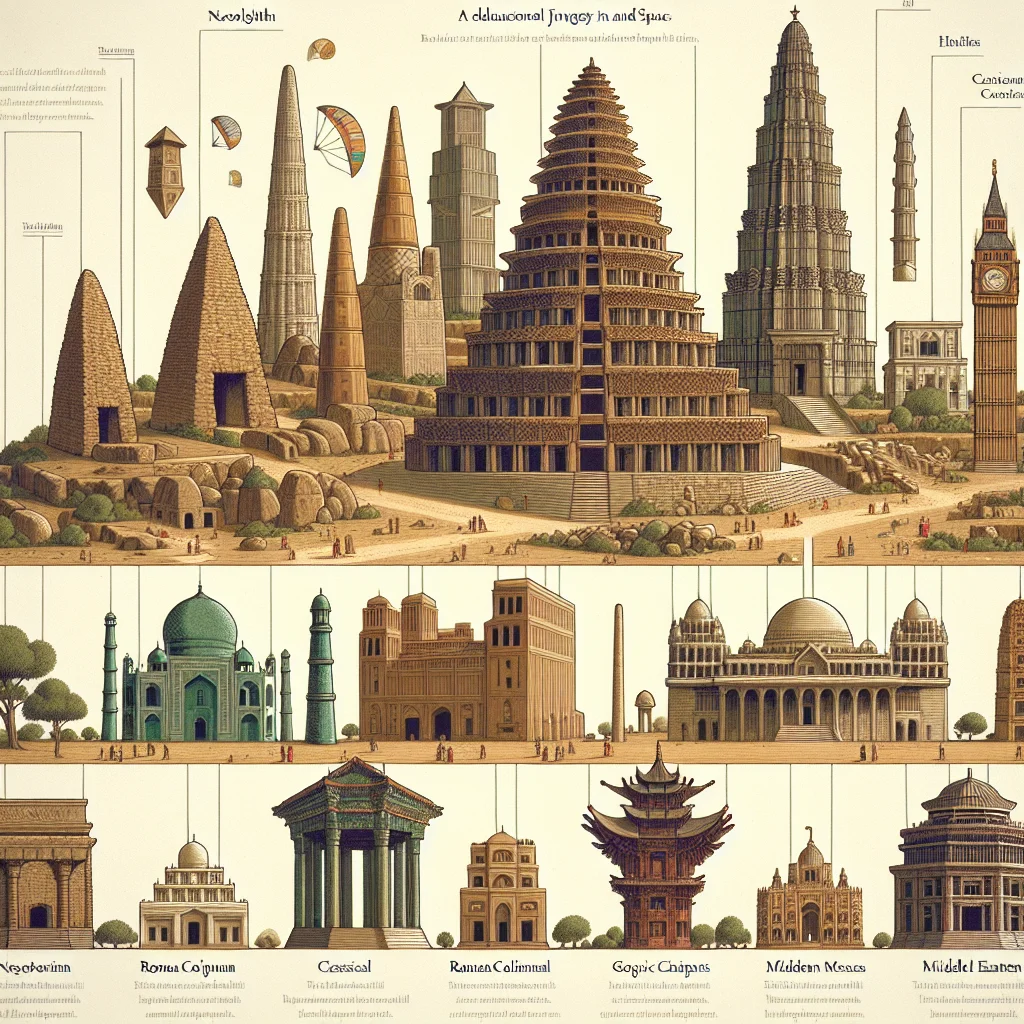Architectural Wonders: Tracing Cultural Evolution Through Design
Embark on a journey across the globe as you explore the fascinating world of architectural wonders. delve into the depths of history and culture as you trace the evolution of societies and their unique design sensibilities. From the ancient pyramids of Egypt to the awe-inspiring skyscrapers of modern-day Dubai, each architectural marvel tells a story of innovation, creativity, and cultural significance. Join us as we unlock the secrets behind these structural masterpieces, offering you a glimpse into the rich tapestry of human experience and the power of design to shape our world. Get ready to be captivated by the sheer beauty and intricacies that lie within these architectural wonders, showcasing the true essence of cultural evolution.
The Significance of Architecture in Cultural Understanding
Architecture is more than just a collection of buildings; it is a testament to the creativity, ingenuity, and cultural values of a society. The way a civilization designs its structures speaks volumes about its beliefs, traditions, and aspirations. From ancient wonders to modern marvels, architectural designs have played a vital role in shaping our understanding of different cultures and their evolution over time.
The role of architectural designs in civilizations
Architecture is not just about creating functional spaces; it is a means of communication. Throughout history, civilizations have used architectural designs to convey their values, beliefs, and social structures. Whether it is the grandeur of ancient Egyptian pyramids, the harmony of Greek temples, or the intricate details of Islamic mosques, each architectural style reflects the unique characteristics of its respective culture.
Understanding society through structural forms
Architecture provides insight into the social and political structures of a society. The layout, organization, and scale of buildings can reveal the power dynamics, social hierarchies, and communal values of a civilization. For example, the pyramids of ancient Egypt were not only tombs for pharaohs but also symbols of their divine authority and the importance of the afterlife in Egyptian society.
The evolution of architectural styles reflecting cultural changes
Architectural styles have evolved over time, mirroring the cultural, technological, and social changes of a society. From the simplicity and symmetry of ancient Greek temples to the elaborate and ornate designs of the Gothic cathedrals, each architectural style reflects the values and aesthetics of its time. Examining the progression of architectural styles allows us to trace the cultural and historical developments of a civilization.
Ancient Architectural Wonders and their Cultural Impressions
Impressions of ancient Egypt through Pyramids
When we think of ancient Egypt, one of the first things that come to mind is the awe-inspiring pyramids. These architectural wonders were not only monumental tombs but also representative of the Egyptian belief in the afterlife. The pyramids, with their precise alignments and intricate construction techniques, showcased the advanced engineering skills and the societal emphasis on the pharaoh’s divine role.
Greek culture as represented in the Parthenon
The Parthenon is a magnificent example of Greek architecture and a symbol of the golden age of Athens. This iconic structure served as a temple dedicated to the goddess Athena. The architectural precision, mathematical proportions, and intricate sculptures of the Parthenon reflect the Greek commitment to harmony, rationality, and beauty. It stands as a testament to the cultural and artistic achievements of ancient Greece.
The Great Wall and ancient Chinese civilization
The Great Wall of China is not only a remarkable feat of engineering but also a representation of the rich cultural heritage of ancient China. The wall served as a defense mechanism against invasions, showcasing the importance of security and protection in Chinese society. Its construction over many centuries reflects the continuity and perseverance of Chinese civilization.
Medieval Architectural Marvels: A Testament to Societal Transformations
Gothic architecture: Symbol of medieval Europe
Gothic architecture emerged in the Middle Ages and is known for its grandeur, soaring heights, and intricate details. Cathedrals such as Notre Dame, Chartres, and Canterbury Cathedral are prime examples of Gothic design. The pointed arches, ribbed vaults, and stained glass windows of Gothic cathedrals created an ethereal ambiance, inspiring awe and reverence among worshippers. These architectural marvels demonstrate the central role of religion in medieval Europe and the ambition of the church to reach towards heaven.
The significance of castles during the Middle Ages
Castles were not only fortifications but also symbols of power, wealth, and feudal society in medieval Europe. These imposing structures, with their thick walls, defensive features, and grand halls, embodied the military and social might of the ruling classes. Castles were not just places of residence but also centers of governance and protection for the surrounding communities.
Arab influence on Spanish architecture: La Alhambra
La Alhambra, located in Granada, Spain, is a testament to the fusion of Moorish and Spanish architectural styles. This unique blend of influences showcases the rich cultural exchange that occurred during the Spanish Reconquista. The intricate geometric patterns, decorative tilework, and lush gardens of La Alhambra reflect the artistic and scientific achievements of Islamic civilization and its enduring impact on Spanish culture.
Renaissance Architecture: A Reflection of Intellectual Revolution
The rebirth of Greek and Roman principles in structures
The Renaissance period witnessed a resurgence of interest in the achievements of ancient Greece and Rome. This fascination with classical knowledge and aesthetics had a profound impact on architectural design. Renaissance architects drew inspiration from the symmetry, proportion, and harmony of ancient structures, incorporating elements such as columns, domes, and arches into their designs. The revival of classical principles in Renaissance architecture symbolized a cultural rebirth and marked a shift towards humanism and intellectual inquiry.
Famous Renaissance architectural masterpieces
The Renaissance produced some of the most iconic architectural masterpieces in history. The works of renowned architects such as Filippo Brunelleschi, Michelangelo, and Leonardo da Vinci exemplify the ideals of the era. The dome of Florence Cathedral, the grandeur of St. Peter’s Basilica in Vatican City, and the exquisite beauty of the Villa Rotonda in Italy showcase the innovation, elegance, and technical mastery of Renaissance architecture.
Impact of Renaissance designs on subsequent architectural styles
The influence of Renaissance architecture extended far beyond the period itself. Its emphasis on geometry, proportion, and classical ideals served as a foundation for later architectural styles, such as Neoclassicism and Beaux-Arts. The legacy of Renaissance design can be seen in the symmetrical facades, grand central spaces, and ornate detailing of many buildings around the world.
Modern Architecture: Diversity in Cultural Expression
Impact of industrial revolution on architectural designs
The industrial revolution brought about monumental changes in society, technology, and architectural practices. The advent of new construction materials, such as steel and glass, revolutionized building techniques and allowed for the creation of vast, open spaces. Industrialization also led to the rise of urbanization, resulting in the need for efficient and functional buildings to accommodate growing populations.
Diversity in architectural styles due to cultural blend
Modern architecture is a melting pot of diverse cultural influences, reflecting the interconnectedness of the globalized world. Architects draw inspiration from various traditions, climates, and contexts in their designs. From Frank Lloyd Wright’s organic architecture in the United States to the minimalist aesthetic of Japanese architect Tadao Ando, modern architecture celebrates cultural diversity and embraces innovation.
Influence of technological advancements on modern architectural styles
Technological advancements have played a pivotal role in shaping modern architectural styles. Developments in structural engineering, sustainability, and building materials have allowed for the creation of daring and innovative designs. From the futuristic forms of Zaha Hadid’s buildings to the eco-friendly concepts of green architecture, technology has empowered architects to push the boundaries of creativity and functionality.
The Influence of Religion on Architecture
Impact of Islam on Middle Eastern architecture
Islamic architecture is distinguished by its unique features, including intricate geometric patterns, decorative calligraphy, and emphasis on inner courtyards. The design of mosques, such as the Great Mosque of Cordoba and the Blue Mosque in Istanbul, reflect the communal nature of Islamic worship and the importance of unity and spiritual contemplation within the Muslim community.
Churches and Cathedrals: Symbols of Christian Influence
Christianity has left an indelible mark on world architecture, with churches and cathedrals serving as focal points of worship and community gathering. From the grandeur of St. Peter’s Basilica in the Vatican to the simplicity of Scandinavian stave churches, Christian architecture encompasses a wide range of styles, each representing the cultural and historical context in which it was built.
Examples of intricately designed temples in Asia
Asia is home to some of the most intricately designed temples in the world. The Angkor Wat in Cambodia, the Golden Pavilion in Kyoto, and the Meenakshi Temple in India are just a few examples of the rich architectural heritage of the region. These temples, adorned with colorful carvings, ornate rooflines, and sacred statues, reflect the spiritual beliefs and reverence for nature ingrained in Asian cultures.
Deciphering Cultural Identity Through Vernacular Architecture
Understanding local customs through vernacular structures
Vernacular architecture refers to the construction methods and designs that are unique to a particular region or community. These structures are influenced by local materials, climate, traditions, and cultural practices. Studying vernacular architecture allows us to understand the values, customs, and lifestyles of different communities, as well as the innovative ways in which they adapt to their environment.
Extant examples of vernacular architecture worldwide
Vernacular architecture can be found across the globe, reflecting the diversity of human ingenuity and adaptation. From the thatched-roof cottages of England to the adobe houses of the American Southwest, each vernacular style showcases the resourcefulness, craftsmanship, and cultural heritage of a specific region. The preservation and appreciation of vernacular architecture are crucial for maintaining cultural diversity and sustainable practices.
Sustainability and cultural significance of vernacular architecture
Vernacular architecture often incorporates sustainable building practices, relying on locally sourced materials and traditional construction techniques. This sensitivity to the environment and cultural heritage makes vernacular architecture a sustainable and resilient approach to design. Through the preservation and revitalization of vernacular structures, communities can maintain their cultural identity while embracing ecological responsibility.
Iconic Landmarks and their Cultural Significance
The Eiffel Tower: A symbol of French innovation
The Eiffel Tower stands as an enduring symbol of French craftsmanship and engineering prowess. Built for the 1889 World’s Fair in Paris, it captivated the world with its innovative use of wrought iron and its soaring height. The Eiffel Tower represents not only technological progress but also the French dedication to aesthetics and cultural expression.
The Taj Mahal: An embodiment of Mughal artistry
The Taj Mahal, a UNESCO World Heritage Site, is a true masterpiece of Muslim architecture. Built by the Mughal emperor Shah Jahan as a mausoleum for his beloved wife, it encapsulates the artistry, symmetry, and intricate detailing of the Mughal Empire. The Taj Mahal’s ethereal beauty and cultural significance have made it an iconic symbol of India and a testament to everlasting love.
The Sydney Opera House: A reflection of Australia’s modernist culture
The Sydney Opera House is an architectural marvel that has become an emblem of Australian identity. Designed by Danish architect Jørn Utzon, it blends modernist principles with natural forms inspired by the surrounding harbor. The distinctive sail-like roofs and the accessibility of the building reflect Australia’s commitment to cultural enrichment and inclusivity.
Architectural Conservation and Cultural Preservation
Role of conservation in preserving cultural heritage
Architectural conservation plays a vital role in preserving the cultural heritage of a society. By safeguarding historical buildings and sites, we can maintain a tangible connection to our past and ensure future generations have the opportunity to appreciate and learn from the architectural achievements of previous civilizations. Conservation efforts involve restoration, maintenance, and documentation to ensure the longevity and integrity of cultural landmarks.
Prominent conservation projects across the world
Numerous conservation projects around the world have successfully restored and preserved architectural wonders. The restoration of the Acropolis in Athens, the conservation of the Great Wall of China, and the rehabilitation of Pompeii in Italy are just a few examples of the dedication and expertise required in preserving our architectural heritage. These projects not only protect the physical structures but also contribute to the understanding and appreciation of their historical and cultural significance.
Challenges faced in the conservation of architectural sites
Conserving architectural sites is a complex and multifaceted task that comes with its fair share of challenges. Factors such as urban development, pollution, natural disasters, and climate change can pose significant threats to the long-term preservation of architectural wonders. Balancing the demands of tourism, sustainable development, and historical authenticity requires careful planning, collaboration, and expertise.
Future of Architecture: Cultural Evolution in the Era of Sustainability
Influence of sustainability on architecture
In an era marked by environmental concerns and resource scarcity, sustainability has become a paramount consideration in architectural design. The integration of renewable energy systems, green building materials, and eco-friendly practices is transforming the way we approach architecture. By embracing sustainable principles, architects can create buildings that harmonize with their surroundings, promote energy efficiency, and contribute to a healthier planet.
Examples of modern sustainable architecture mirroring cultural progression
Modern sustainable architecture showcases the harmony between cultural expression and environmental responsibility. The Bahrain World Trade Center, with its integrated wind turbines, symbolizes Gulf culture’s embrace of renewable energy. The Khoo Teck Puat Hospital in Singapore blends sustainable design with Asian aesthetics and healing traditions. These examples demonstrate how sustainable architecture can embody cultural values and contribute positively to the built environment.
The role of future architects in cultural preservation and sustainability
As custodians of the built environment, future architects have a crucial role to play in cultural preservation and sustainability. By incorporating historical context, embracing local materials and traditions, and prioritizing sustainable practices, architects can create designs that respect cultural identities, address societal needs, and mitigate the impact on the planet. The collaboration between architects, communities, and policymakers will be vital in shaping the future of architecture as a force for cultural evolution and sustainability.
In conclusion, architecture serves as a lens through which we can understand and appreciate the diverse cultures that have shaped our world. From ancient wonders to modern marvels, architectural designs offer insights into the beliefs, values, and aspirations of different societies. By studying and preserving architectural heritage, we can ensure that these cultural treasures continue to inspire and educate future generations, fostering a more inclusive and interconnected global community.







